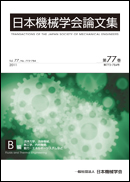Volume 77, Issue 780
Displaying 1-9 of 9 articles from this issue
- |<
- <
- 1
- >
- >|
Fluids Engineering
Regular Paper
-
2011 Volume 77 Issue 780 Pages 1609-1619
Published: 2011
Released on J-STAGE: August 25, 2011
Download PDF (1043K) -
2011 Volume 77 Issue 780 Pages 1620-1629
Published: 2011
Released on J-STAGE: August 25, 2011
Download PDF (1014K) -
2011 Volume 77 Issue 780 Pages 1630-1640
Published: 2011
Released on J-STAGE: August 25, 2011
Download PDF (1302K)
Technical Paper
-
2011 Volume 77 Issue 780 Pages 1641-1651
Published: 2011
Released on J-STAGE: August 25, 2011
Download PDF (3226K)
Thermal Engineering
Regular Paper
-
2011 Volume 77 Issue 780 Pages 1652-1658
Published: 2011
Released on J-STAGE: August 25, 2011
Download PDF (834K) -
2011 Volume 77 Issue 780 Pages 1659-1671
Published: 2011
Released on J-STAGE: August 25, 2011
Download PDF (852K) -
2011 Volume 77 Issue 780 Pages 1672-1686
Published: 2011
Released on J-STAGE: August 25, 2011
Download PDF (1207K)
Errata
-
2011 Volume 77 Issue 780 Pages 1687
Published: 2011
Released on J-STAGE: August 25, 2011
Download PDF (800K) -
2011 Volume 77 Issue 780 Pages 1688
Published: 2011
Released on J-STAGE: August 25, 2011
Download PDF (126K)
- |<
- <
- 1
- >
- >|
